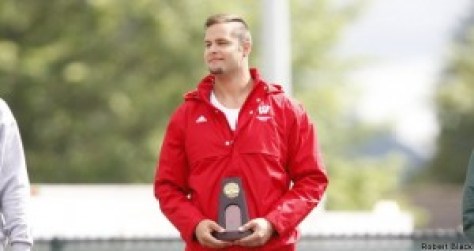There is a large man handling the baggage. Literally and figuratively.
After a pleasant chat with Moscow discus silver medalist Melina Robert-Michon in the lobby of the Hyatt Grand Central, I turned around and ran into the gold medalist from that meet and from the London Olympics, Sandra Perkovic.
There is not a more dominant athlete on the planet right now than Sandra. Unlike the elite sprinters who for some reason get all the attention in track and field, she will show up anywhere, anytime, take on anybody, and more often than not smash them.
One thing I’ve noticed in talking to a couple of the dominant throwers of the past few years, and in observing Usain Bolt over the weekend in New York (more on that later) is that the effort required to stay on top can be exhausting.
The first time I spoke to Valeri Adams was at the New York Diamond League meet in 2010 when she was twenty-five years old, and the strain of the incessant travel and competition was already apparent. Granted, Val was going through some personal and professional upheavals at the time, but it sure didn’t seem like she was enjoying being the greatest shot putter in the world.
I interviewed her in New York again last year, just after she had nailed down her 50th consecutive victory making her arguably the greatest putter ever. She was polite, as always, but there was no sense of celebration about the milestone she had just achieved. On the brink of turning thirty and nursing a bad shoulder which would require off-season surgery, she seemed to look forward to a not-too-distant retirement.
When I talked with Robert Harting in New York last year, he too seemed to be looking forward to the end after several years of dominating his event. And that was before he injured his knee. I had a chance to watch him practice this past March, as he fought to regain his form following surgery on that knee and he literally seethed his way through the training session. He looked pissed off while stretching, while throwing, while retrieving his discs, while packing up his stuff. I initially took up a spot along a fence that ran behind the cage, but I was so intimidated by him that I finally hopped the fence just to have some kind of barrier between us.
But I don’t blame him for being upset. It must suck to feel mortal when you are used to being…well, a hell of a lot better than mortal. When you’ve entered the ring needing a PR on your final throw at the World Championships and nailed that PR in front of 60,000 fans, when you’ve won the Olympics and another World Championship on days when you didn’t have your best stuff, when you’ve always been able to conjure up the strength, will, savvy or whatever you needed on a particular day to gain a victory…it has to be very disconcerting to think that you might not ever be able to do that again.
Sandra, queen of the women’s discus for the past four years, seems, in contrast, still to be enjoying her reign. And I think the main reason for that was standing a few feet away as she checked in at the Hyatt.
Wrangling a small mountain of luggage was her boyfriend/coach, former NCAA shot put champion Edis Elkasevic.
Edis is a very large, very good-natured man and, I think. the perfect buffer between Sandra and the demons that can beset an elite athlete. I’ve seen Sandra compete three times since Edis became her coach, and it is really fun to watch them interact.
John Smith has said that the job of a coach during a competition is to “keep the train from going off the rails.” Edis does this masterfully.
He and Sandra confer after every throw, and though I do not speak Croatian, I’m pretty sure I’ve seen him goad her, encourage her, give her technical advice, whatever it takes.
Clearly, Sandra derives great comfort from Edis’ presence, and I suspect that it is largely due to their relationship that she has not yet been done in by the stress of travelling the world while taking on all comers.
I went over to say hello to Edis, and to inquire how Sandra was feeling coming into the New York meet. “Good! Good!” he replied in his usual jovial manner. “She had a small injury but now everything is good. Her timing is better. With the 1k disc, timing is everything!”
With that, he gathered up the baggage, excused himself, and joined Sandra for the walk across the large, chaotic lobby. Wherever they were headed, they’d go there together.




































































